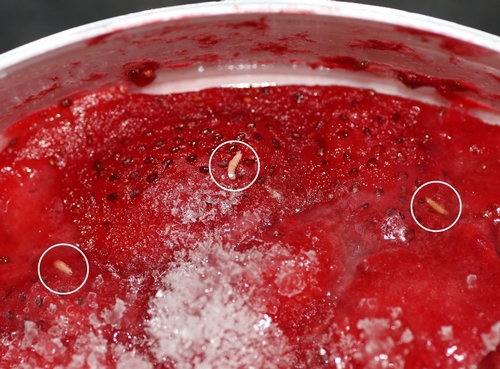Spotted wing drosophila (SWD), Drosophila suzukii has become a potential concern for strawberries following its damage to cherries, blackberries, raspberries, and blueberries in coastal California. Other species of Drosophila are morphologically not equipped to attack ripening strawberries. Their ovipositors or egg laying parts are not strong enough to penetrate unripe or ripening berries. They may damage overripe strawberries left on the crop, but since such berries are not marketed, they have not been an issue for growers. However, SWD has a heavily sclerotized, serrated ovipositor that enables it to lay eggs in fruits that are not fully ripe.
In response to the concern that SWD could be a potential pest to strawberries, I monitored some fields in Santa Maria last year. Five fields – four conventional and one organic – in various parts of Santa Maria were monitored for five months from March to July, 2011. Two kinds of traps, one with apple cider vinegar and the other with yeast-sugar extract were used in each location and were observed every week. During this monitoring there were no signs of SWD in any of these traps. However, I recently received some specimens from a Santa Maria grower in which I found what seemed to be the females of SWD among other Drosophila sp. There were no males with their obvious characteristic of spotted wings, but the following and other characters of the females suggest these were SWD:
- Hard and dark (sclerotized) ovipositor with prominent serrations or saw-teeth that enable the fly to lay eggs in intact ripening fruit.
- Antennae with branched bristle-like part called arista.
According to Dr. Brian Cabrera, Santa Barbara County Ag Commissioner Entomologist, there haven't been any SWD infestations that were brought to his attention. So, it appears to be the first report of SWD in Santa Maria strawberries. Sanitation, trapping, and chemical control are among the available options to manage SWD. Close monitoring is necessary in vulnerable areas. More details about identifying and managing SWD can be found in the listed references. Here is a brief note about this pest.
SWD belongs to the group of flies that are generally known as vinegar flies or lesser fruit flies. It was initially known as cherry fruit fly in 1930s and is now referred to as spotted wing drosophila.
Origin and distribution: It is traditionally known to be a pest in Asia, but it is now reported in Neo Tropics, North America, and Europe. In the US, it has been found in Hawaii, Washington, Oregon, California, and Florida.
Host range: They generally infest thin-skinned fruit and prefer temperate climate. Host range includes apple, blackberry, blueberry, cherry, dogwood, grape, mulberry, peach, persimmons, plum, raspberry, and strawberry.
Biology: SWD prefer 68-86 oF and overwinter as adults. Various sources suggested 5-10 generations per year. According to Kanzawa (1939) egg laying starts in spring and can last for 10-59 days. Females lay an average of 384 eggs at 7-16 per day. Eggs hatch in 2-72 hours and larval stage lasts for 3-13 days. Pupation takes place inside the fruit or in the soil and lasts for 3-15 days. Life cycle takes anywhere from 21-25 days at 59 oF to 7 days at 82 oF.
Damage: Other fruit flies usually infest overripe and fallen fruit, but SWD infests fresh fruit because of its powerful ovipositor. Adults feed on fallen fruit but lay their eggs under the skin of intact fruit. Softening and collapse of the tissue results from larval feeding inside the fruit. Oviposition holes can be seen on the fruit with close observation. In addition to the direct damage, SWD makes the infested fruit vulnerable to other pests and diseases. Monitoring SWD is very important to avoid harvesting and marketing infested berries.
Maggots (of unknown species) in infested fruits showing up in processed strawberry container. Photo by Surendra Dara
http://ucanr.edu/articlefeedback
References
Calabria G., J. Máca, G. Bächli, L. Serra and M. Pascual. 2012. First records of the potential pest species Drosophila suzukii (Diptera: Drosophilidae) in Europe. J. Appl. Entomol. 136:139-147.
Kanzawa, T. 1939. Studies on Drosophila suzukii Mats. 49 pp. (http://www.cabdirect.org/abstracts/19410501073.html;jsessionid=81E9221496390100F7C13052E18F8079)
http://www.agf.gov.bc.ca/cropprot/swd_identification.pdf
http://www.al.gov.bc.ca/cropprot/swd.htm
http://entnemdept.ufl.edu/creatures/fruit/flies/drosophila_suzukii.htm
http://www.freshfromflorida.com/pi/pest-alerts/drosophila-suzukii.html
http://www.ipm.ucdavis.edu/EXOTIC/drosophila.html



